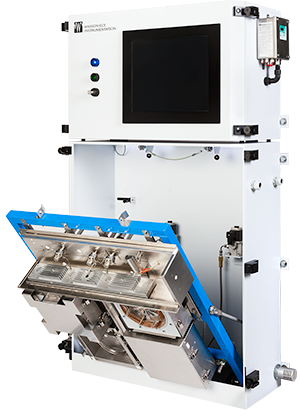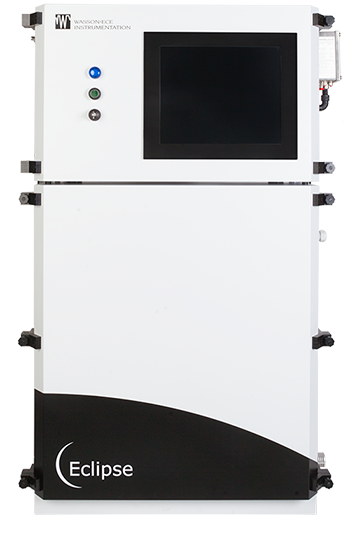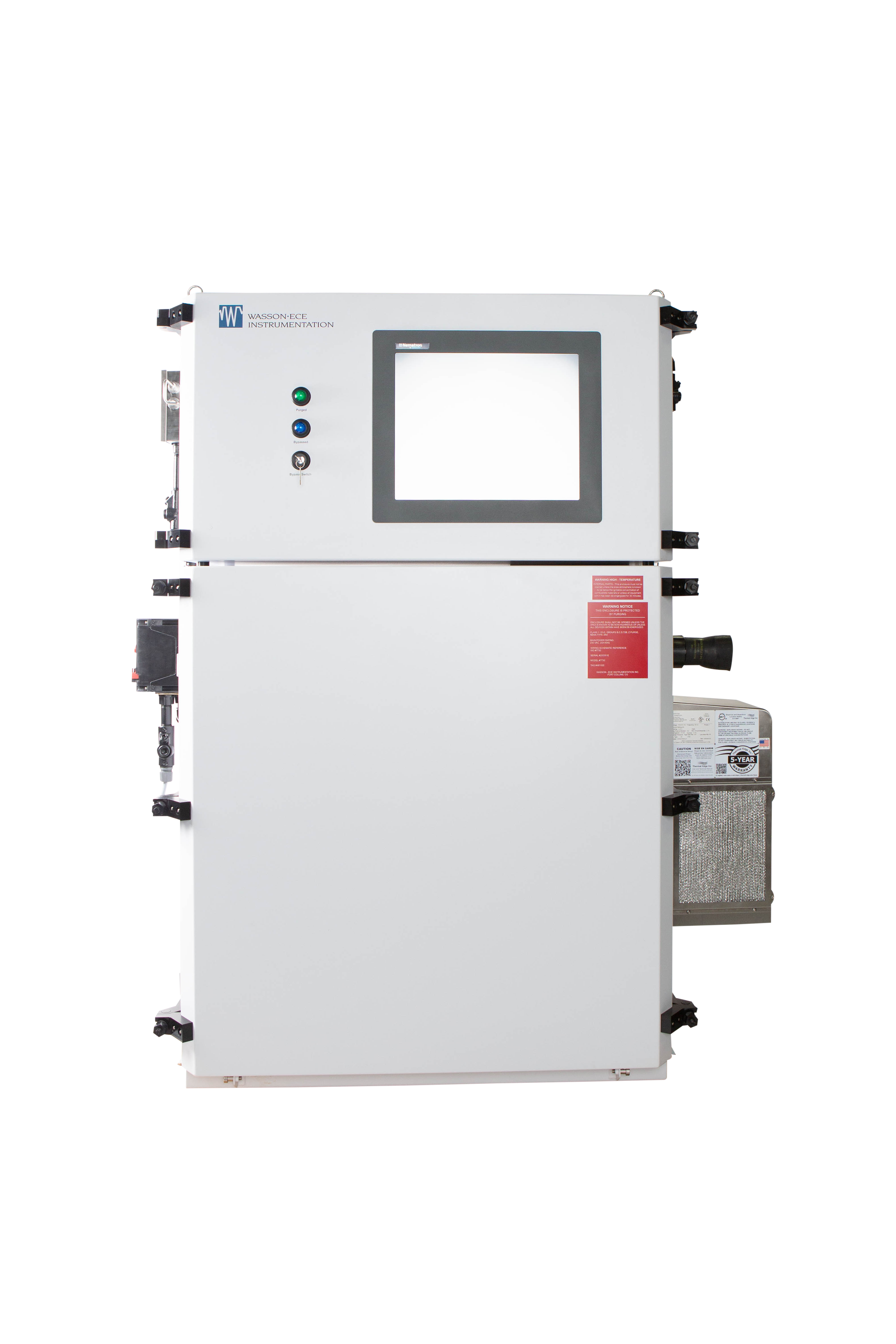
The World of Process Chromatographs Has Just Been Eclipsed

The Wasson-ECE Eclipse Process Gas Chromatograph delivers laboratory-quality chromatographic analysis in process environments. Unlike conventional process analyzers limited to packed columns and fixed-temperature operation, the Eclipse features a patented micro-convection oven system that enables precise programmable temperature control. This breakthrough technology supports capillary column analyses, dramatically expanding analytical capabilities for process monitoring applications.
Built on decades of Wasson-ECE expertise in laboratory and process analytics, the Eclipse Analyzer bridges the gap between laboratory precision and process requirements. Wasson-ECE engineers designed the system with comprehensive flexibility to tackle complex analytical challenges. The Eclipse accommodates dual micro-convection ovens, dual isothermal ovens, advanced valving systems, and up to four detectors—delivering modular configurations that adapt to your specific analytical needs.
Unlike any other process analyzer, the Eclipse harnesses capillary column chromatography while supporting multiple detector configurations—eliminating the need for multiple process GC units in a single, comprehensive solution.
- Capacity for up to four detectors (FID, TCD and PDHID)
- Capacity for up to eight capillary columns
- Full electronic pressure programming
- Capacity for two programmable micro-convection ovens
- Capacity for two isothermal ovens
- Sampling system to accommodate up to 16 sample streams
- Hermes Process Software
- Modbus RTU communications
- Rated for Class I Division 2 or ATEX Zone 2 hazardous areas
The Wasson-ECE Eclipse Process Gas Chromatograph delivers laboratory-quality chromatographic analysis in process environments. Unlike conventional process analyzers limited to packed columns and fixed-temperature operation, the Eclipse features a patented micro-convection oven system that enables precise programmable temperature control. This breakthrough technology supports capillary column analyses, dramatically expanding analytical capabilities for process monitoring applications.
Built on decades of Wasson-ECE expertise in laboratory and process analytics, the Eclipse Analyzer bridges the gap between laboratory precision and process requirements. Wasson-ECE engineers designed the system with comprehensive flexibility to tackle complex analytical challenges. The Eclipse accommodates dual micro-convection ovens, dual isothermal ovens, advanced valving systems, and up to four detectors—delivering modular configurations that adapt to your specific analytical needs.
Unlike any other process analyzer, the Eclipse harnesses capillary column chromatography while supporting multiple detector configurations—eliminating the need for multiple process GC units in a single, comprehensive solution.
- Capacity for up to four detectors (FID, TCD and PDHID)
- Capacity for up to eight capillary columns
- Full electronic pressure programming
- Capacity for two programmable micro-convection ovens
- Capacity for two isothermal ovens
- Sampling system to accommodate up to 16 sample streams
- Hermes Process Software
- Modbus RTU communications
- Rated for Class I Division 2 or ATEX Zone 2 hazardous areas
Bringing the resolving power and increased sensitivity of capillary chromatography to your process streams
- Detailed Hydrocarbon Analysis
- PIONA analysis
- Benzene, toluene, xylenes
- Low level permanent gases - nitrogen, oxygen, carbon dioxide, methane and others
- Oxygenates - alcohols, ethers, aldehydes and ketones
- C1-20 hydrocarbon speciation
- PIONA analysis
- Ammonia
- Detailed C5+ hydrocarbons
- Oxygenates - alcohols, ethers, aldehydes and ketones
- Sulfur compounds - H2S, SO2, COS, thiols and other sulfur species
- Nitriles
- Low level permanent gases - nitrogen, oxygen, carbon dioxide, methane and others
- Arsine, phosphine, chlorine
- Sulfur compounds - H2S, SO2, COS, thiols and other sulfur species
- Low level permanent gases - nitrogen, oxygen, carbon dioxide, methane and others
- Ammonia
- PIONA
- Chlorosilanes, disilane, disiloxane
- Low level permanent gases - nitrogen, oxygen, carbon dioxide, methane and others
- Hydrocarbons
- HRVOCs
- Discharge water
- Fence-line Monitoring
Eclipse PGCs bring the resolving power and sensitivity of capillary chromatography to online analytics. Monitor stream conditions in real-time – know now!
Stream impurities? Know now!
Catalyst poisons? Know now!
Eclipse FID chromatogram showing separation of C1-C7 hydrocarbons and backflush of heavier species.
Application
Online RGA
Eclipse

Eclipse FID chromatogram showing speciation of C8-20 hydrocarbons.
Application
Online RGA
Eclipse

Eclipse TCD chromatogram showing separation of common permanent gases and H2S.
Application
Online RGA
Eclipse

Eclipse delivers outstanding control of temperatures, pressures and backpressure control resulting in excellent retention time reproducibility. Additionally, split inlet performance and mass flow control deliver highly reproducible peak areas. These data clearly demonstrate the exceptional analytical capabilities of Eclipse PGCs.

The world’s only GC-MS process analyzer!

Neutrino expands the Eclipse platform with the ability to reach lower detection limits with unparalleled identification accuracy. Combining the separation of gas chromatography with the identification power an Agilent 5977B mass spectrometer, Neutrino allows users to detect and quantify components that would be impossible with other detectors.
The Wasson-ECE Neutrino combines the capillary chromatography capabilities of the Eclipse Process Analyzer with the powerful mass selective detector (MSD) to provide positive identification and quantification of impurities in process samples. The Neutrino supports configuration with additional detectors, including FID, TCD, and PDHID, enabling comprehensive multi-component analysis within a single analyzer platform.
The Neutrino accommodates process analysis of samples that previously required laboratory testing, delivering accelerated feedback and enhanced operational efficiency for process control.
Wasson-ECE possesses extensive expertise in configuring GC-MS systems for diverse and challenging applications. The Neutrino incorporates the same Agilent MSD technology utilized in laboratory applications, ensuring seamless transition to process analysis.
Neutrino is the world’s only GC-MS process analyzer. The MSD is capable of trace analysis and positive identification of a wide range of components. The Micro-Convection oven provides precise temperature controls essential for laboratory-quality capillary column chromatography, while Wasson-ECE’s valve chromatography expertise enables unparalleled process analysis capabilities.
- Agilent 5977C MSD with High Efficiency Source (HES) or Extractor Ion Source
- Capability to include FID, TCD and PDHID detectors
- Capacity for up to 8 capillary columns
- Full electronic pressure programming
- Capacity for two ovens (programmable micro-convection oven and/or isothermal)
- Sampling system to accommodate up to 16 sample streams
- Hermes Process Software
- Modbus RTU communications
- Rated for Class I Division 2 or ATEX Zone 2 hazardous areas
Sample Types
- Blending Stocks, LNG & Engine Fuels
- Nitriles
- Refinery Gas
- Natural Gas Liquids
- Petrochemicals & Monomer Analysis
- Environmental monitoring
Components
- Arsine, phosphine
- Sulfur compounds - H2S, SO2, COS, thiols and other sulfur species
- Low level permanent gases - nitrogen, oxygen, carbon dioxide, methane
- Oxygenates - alcohols, ethers, aldehydes and ketones
Eclipse PDHID chromatogram of common permanent gases, including CO and CO2.
Application
Impurities in ethylene and propylene
Neutrino (GC-MS) + PDHID

Process Data Communications
Eclipse features a 19” touchscreen interface for walk-up interaction with the unit. Instrument status, data analysis and configuration are accessible from the front display or via remote management. Interfacing between the Eclipse PGC and the plant distributed control system (DCS) allows for rapid responses to changing stream conditions.
- Multiple independent network interface cards possible
- Modbus RTU RS485
- REST automation
- 19” touchscreen
Safety Features
- NFPA - Class 1, Division 2, Groups B, C, D, T3, NEMA 4X
- ATEX Zone 2 Ex pxb IIC T2B Gc, IP65
- Purged enclosure 20 CFM
- Programmable rapid purge on start-up
- Remote Injection
Wall Mounted and Easy to Maintain
With an enclosure designed for hazardous locations and mounted on a pivoting inner chassis, high precision components are easily serviceable and protected from even the toughest environments.
Dimensions: 21” D x 71” H x 44” W
Two 208-240 VAC/50/60 Hz/20A circuits (one for Neutrino and one for sample system)
One 208-240 VAC/50/60Hz/5A circuit for the MSD rough pump
Installation in
- an analyzer building, incoming purge air to be less than 40°C or
- 3-sided shelter with water, sunlight and UV protection and maximum ambient temperature of 40°C
Instrument air, oil/moisture free, 20 SCFM, 90-150 psig, 3/8” tubing connection, 40°C maximum.
Additional required gases dependent on configuration
The only on-line process VUV (Vacuum Ultraviolet) analyzer.

Wasson-ECE has the world-wide exclusive ability to bring vacuum ultraviolet spectroscopy to process GC. VUV is a universal detector delivering unique spectral signatures of compounds. When coupled with GC retention time data, this combination allows for detailed characterization of hydrocarbon mixtures (PIONA, ASTM D8071 and much more). Eclipse-VUV can be designed for both Class 1 Division 2 and ATEX Zone 2 rated areas.
Acquiring detailed composition of fuel products in real-time on the process line allows for rapid response to process disruptions.
Built on decades of Wasson-ECE expertise in laboratory and process analytics, the Eclipse Analyzer bridges the gap between laboratory precision and process requirements. Wasson-ECE has been using the VUV analyzer for laboratory applications for over 7 years. Using the same VUV and incorporating it into our process instrumentation allow for the seamless transition of applications, already proven in the lab, to be brought out into process environment.
Eclipse-VUV is the only online VUV process analyzer. The VUV allows for the detailed composition of liquid fuel products, verified by spectral analysis. Along with Wasson-ECE process instrumentation hardware including micro-convection ovens, capillary columns and electronic pressure controls, the instrument provides repeatable, accurate and detailed breakdown of liquid fuel products.
- Compatible with VGA-100 and VGA-101
- Sample system with connections for multiple sample streams, and QC standards.
- Hermes Process Software
- Modbus RTU communications
- Rated for Class I Division 2 or ATEX Zone 2 hazardous areas
- Micro-convection oven for programmable heating of a capillary column
- Electronic pressure control for repeatable retention times and results
- ASTM D8071
- ASTM D8267
- ASTM D8368
- ASTM D8369
Xylenes provide an excellent example of the power of VUV to differentiate between very similar coeluting compounds. Xylene isomers co-elute chromatographically (A) but exhibit spectroscopically distinct features when scanned between 120-240nm (B). VUV deconvolution algorithms use these features to correctly match the isomers to the reference spectra in the compound library.
Application
PIONA analysis, D8071
E-VUV


- ASTM D8071
- ASTM D8267
- ASTM D8368
- ASTM D8369
Eclipse features a 19” touchscreen interface for walk-up interaction with the unit. Instrument status, data analysis and configuration are accessible from the front display or via remote management. Interfacing between the Eclipse PGC and the plant distributed control system (DCS) allows for rapid responses to changing stream conditions.
- Multiple independent network interface cards possible
- Modbus RTU RS485
- REST automation
- 19” touchscreen
- NFPA - Class 1, Division 2, Groups B, C, D, T3, NEMA 4X
- ATEX Zone 2 Ex pxb IIC T2B Gc, IP65
- Purged enclosure 20 CFM
- Programmable rapid purge on start-up
- Remote Injection
With an enclosure designed for hazardous locations and mounted on a pivoting inner chassis, high precision components are easily serviceable and protected from even the toughest environments.
21” D x 71” H x 44” W (53.45 x 180.34 x 111.76 cm)
Two 208-240 VAC/50/60 Hz/20A circuits (one for Eclipse-VUV and one for sample system)
Plant air, 90-150 psig (free of oil, moisture, and particulates <0.01 µm) - 20 SCFM
Helium (99.995%), carrier gas, 40 SCCM, 75 psig
Installation in
- an analyzer building, incoming purge air to be less than 43°C
- or 3-sided shelter with water, sunlight and UV protection and maximum ambient temperature of 43°C
Eclipse features a 19” touchscreen interface for walk-up interaction with the unit. Instrument status, data analysis and configuration are accessible from the front display or via remote management. Interfacing between the Eclipse PGC and the plant distributed control system (DCS) allows for rapid responses to changing stream conditions.
- Multiple independent network interface cards possible
- Modbus RTU RS485
- REST automation
- 19” touchscreen
- NFPA - Class 1, Division 2, Groups B, C, D, T3, NEMA 4X
- ATEX Zone 2 Ex pxb IIC T2B Gc, IP65
- Purged enclosure 20 CFM
- Programmable rapid purge on start-up
- Remote Injection
With an enclosure designed for hazardous locations and mounted on a pivoting inner chassis, high precision components are easily serviceable and protected from even the toughest environments.
18” D x 71” H x 39” W
Two 208-240 VAC/50/60 Hz/20A circuits: one for the sample system and one for the gas chromatograph.
Installation in
- an analyzer building, incoming purge air to be less than 40°C or
- 3-sided shelter with water, sunlight and UV protection and maximum ambient temperature of 40°C
Instrument air, oil/moisture free, 20 SCFM, 90-150 psig, 3/8” tubing connection, 40°C maximum.
Additional required gases dependent on configuration

Eclipse Brochure
Wasson-ECE Instrumentation
101 Rome Ct., Fort Collins, Colorado USA 80524
Phone: +1 (970) 221-9179
Fax: +1 (970) 221-9364
© 2025. All Rights Reserved.
When you can't afford to be wrong. TM